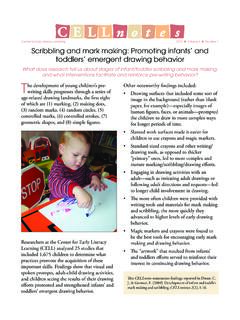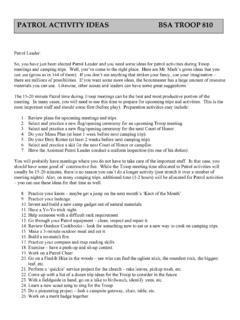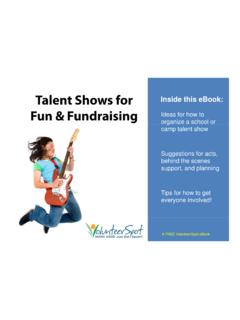Transcription of Especially for parents of toddlers! My Turn, Your Turn
1 My Turn, Your TurnWhat is the practice?What does the practice look like?How do you do the practice?How do you knowthe practice worked?pracctie sCELLCENTER for EARLY LITERACY LEARNINGE specially for parents of toddlers! Most toddlers are starting to develop the ability to take part in real interactions with the people around them. They are beginning to learn how to talk and play with parents , teachers, and peers. But before children can take part in meaningful interactions, they need to learn skills like how to take turns. Involve your child in taking turns with games, conversations, fin-ger plays, and sharing toys. These activities will help develop the skills he needs to interact well with others.
2 Turn-taking is one of the most basic parts of being able to communicate with others. Toddlers who get lots of practice taking turns will have an easier time talking and playing with daily routine includes many opportunities for turn taking. In fact, almost anything you do with your toddler can be a chance to practice turn taking. Simply be sure to alternate which one of you is doing the activity. Keep talking about what you re each doing during the activity. Follow your child s interest. Use whatever toy your toddler is interested in playing with to start a conversation. Start by commenting on what she is doing with the toy.
3 When it s your turn, you can ask her to talk about what you are doing. Or, you could choose to each talk during your turn. Many toddlers will naturally hand you a favorite toy. You can encourage this handing you a toy by using words like my turn and your turn. Start out by keeping the turns short. Younger toddlers don t have a long attention span yet. It also helps to maintain toddlers interest by imitating the way they are playing with toys. Reading books is a great opportunity for turn taking. You can switch who turns the pages, who comments on the pictures, or who says the words. Favorite songs and nursery rhymes can also be used that way, with alternating lines for each of you.
4 For toddlers who enjoy physical activity, try tossing or kicking a ball between you as a way of taking turns. Taking turns dancing, or imitating each others move-ments can be very fun. Your toddler will still learn about waiting his turn and watching to see what you are doing. His language skills can be developed by using words to describe what each of you does during your turns. Does your toddler offer you a toy and use words like my turn ? Does he understand that only one person can talk at a time in a con-versation? Is he excited about talking with you, his peers, and others?Talking and ListeningPlay with your toddler by taking turns with a toy.
5 Talk about what you are doing and encouraging her to do the same. Look at a book together and take turns describing what you see. Toss a ball back and forth as each of you says Mine! or My turn! when it s your turn. These are just a few of the kinds of activities that prepare your toddler for successful communication. CELLTake a look at more toddlers taking turnsHooptastic Way To Share Turning PagesTime for a CountdownTwo-year-old Emilee, who has language delays, loves play-ing in the sand with her brother Matt at the beach. But Matt has the green plastic pail she wants to fill with wet sand. No, Emilee, Matt tells her. I m using it.
6 Emilee starts to get upset, but their dad says, Matt is going to have it for ten more seconds, then you get a turn, Emilee. Watch and count with me. Emilee watches her dad as he counts slowly to ten, then Matt hands her the green pail. She looks at it in amazement, then grins and begins filling it with sand. After a couple of minutes, Dad says, It s almost time for Matt s turn again. Emilee listens to her dad and brother count to Tina, who is almost 3 years old, is an energetic, active little girl who doesn t always like to share toys. Her dad helps her with this by play-ing one of Tina s favorite games with her at their neighborhood court: shooting a basketball.
7 Your shot, Tina, her dad calls, as he hands the ball to Tina and lifts her toward the basket. She laughs with glee as she rises through the air, touches the rim, and pushes the ball through the hoop. My turn now! Dad yells. Then he does some fancy drib-bling and makes a shot. Now me, squeals Tina, waving her arms, Oh, is it your turn? Okay, Dad says, and hands off the ball and lifts Tina through the air. They play the game back and forth while talking about their basketball skills and laughing when they miss. Each time Tina passes her dad the ball, he waits for her to ask for it back. This allows her to practice both her language and turn-taking , age 26 months, and his mom enjoy reading together by the fireplace after lunch, just before Gray s nap.
8 Gray likes to hold the book on his own. Sometimes he likes to talk about what s happening on the page. Let s take turns, his mom suggests. You tell me what s on this page. Gray describes the dog and the boy on the first page, then flips it over. My turn now? his mom asks, and Gray nods. His mom reads the text, then Gray says My turn, and reads the next page. Together, they listen to each other s versions of the story and actions through to the end of the book. CELL practices Is a publication of the Center for Early Literacy Learning (CELL), funded by the Department of Education, Office of Special Education Programs (H326B060010).
9 The opinions expressed, however, are those of CELL and not necessarily those of the Department of Education. Copyright 2010 by the Orelena Hawks Puckett Institute, Asheville, North Carolina ( ).ten again. Now give it back to me, Emilee, Matt says. She does give it back, eager to use this magic formula to get the toys she wants without a fight. CELL CELLL isten Up!What is the practice?What does the practice look like?How do you do the practice?How do you knowthe practice worked?pracctie sCELLCENTER for EARLY LITERACY LEARNINGE specially for parents of toddlers! One of the most important skills your toddler needs to learn is how to listen.
10 To become good speakers and readers, toddlers need to be able to hear when sounds are the same or different. Toddlers also need to understand what other people are saying to can help your toddler develop strong listening skills by playing games that involve both words and sounds. When you give her many everyday opportunities to practice listening skills you help her with listening, speak-ing, and ultimately, reading. Help your toddler pay attention to what he hears with fun parent-child activities. Play listening games such as Simon Says and Follow the Leader. Do the motions to songs, stories, and fingerplays. Act out the differences in sounds that are fast, slow, loud, soft, and more.










